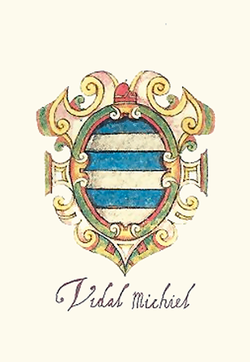This article needs additional citations for verification .(February 2024) |
Vitale II Michiel | |
|---|---|
 Copper engraving of Vitale II Michiel, 1840 | |
| Doge of Venice | |
| In office 1155–1172 | |
| Preceded by | Domenico Morosini |
| Succeeded by | Sebastiano Ziani |
| Personal details | |
| Born | Unknown |
| Died | 1172 |

Vitale II Michiel (also spelled Vital II Michiel) was Doge of Venice from 1155 to 1172. [1]
Vitale Michiel became Doge of Venice at a time when Venice's relations with the Byzantine Empire were becoming increasingly strained. At the same time,on account of the growing profitability of mainland Italian markets,Venice was trying to remain on good terms with the Western Emperor,Frederick Barbarossa. But eventually,Venice was to come into conflict with both East and West.
In 1158,much of Northern Italy was in open revolt against Frederick after his crossing of the Alps. In August 1159,the towns of Milan,Crema,Brescia and Piacenza founded the Lombard League with backing from Pope Adrian and the Kingdom of Sicily. On September 1,1159,Pope Adrian died,and during the enthronement of his elected successor,Alexander III,the papacy was usurped by a supporter of Frederick,Victor IV. The papacy was disputed for the next 18 years,although most of Europe backed Alexander III. Venice also declared for Alexander III,fearing that Frederick would treat Venice in much the same way as the rest of North Italy. Padua,Verona and Ferrara,which were loyal to Frederick,attacked Venice but were easily defeated. Next,Frederick engaged The Patriarch of Aquileia to attack Grado. This attack also failed,and merely resulted in Grado having to pay an annual tribute to Venice - a dozen pigs annually on the Wednesday before Lent. These pigs were chased around the Piazza on the following day by the people of Venice.
Although Frederick Barbarossa would have liked Venice subdued,he had more pressing problems to deal with elsewhere in Italy. For example,he wanted to reclaim Ancona from Byzantium and to continue opposition to Norman Sicily. On these fronts he failed. However,he succeeded in installing another anti-Pope in Rome - Paschal. The Romans fought ferociously to keep Frederick's forces out. St Peter's Basilica was heavily defended and held out for eight days. But eventually the Imperial forces broke in and left the marble pavement of the nave strewn with dead and dying,and the high altar itself stained with blood. On July 30,1167 anti-Pope Paschal celebrated Mass. Subsequently,Frederick's army was virtually destroyed by pestilence,which most of Europe considered divine retribution for the desecration of St. Peter's. Venice became a founding state of the Greater Lombard League on December 1,1167.
At this time,there were many Latins in Constantinople enjoying privileges given them by Manuel and earlier Byzantine Emperors. Most of these were Venetians,who were generally regarded as arrogant,and scornful of the Eastern Empire. Manuel began to reduce the privileges of Venice,and to improve the position of her rivals:Pisa,Genoa and Amalfi. Manuel also captured much of the Dalmatian coast from Stephen III of Hungary,which was another irritation to Venice.